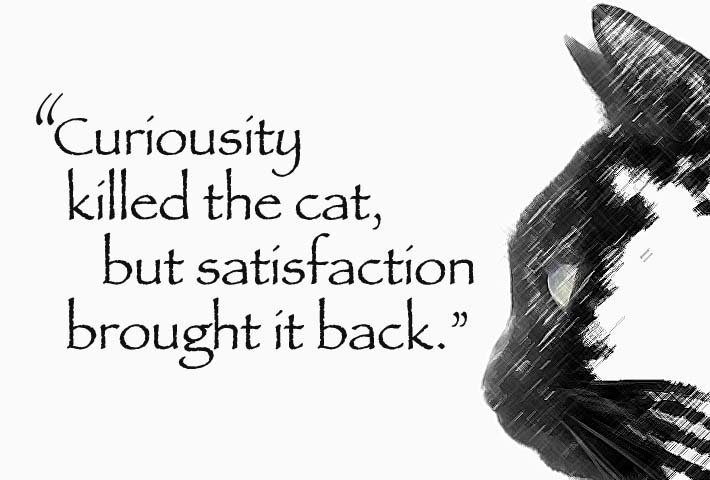
“Curiosity killed the cat full quote” has often left many pondering its profound meaning. The popular saying, ‘curiosity killed the cat full quote,’ serves as a timeless reminder of the consequences of excessive inquisitiveness. However, it’s crucial to delve deeper into the origins and implications of this intriguing phrase. Exploring the nuances of ‘curiosity killed the cat full quote’ unveils a rich discussion on the delicate balance between exploration and caution. Join us on a journey to uncover the true essence behind this enigmatic statement.
The Story Behind the Famous Quote: “Curiosity Killed the Cat”
Welcome, young readers! Have you ever heard the saying “Curiosity Killed the Cat”? It’s a famous phrase that many people use, but have you ever wondered where it comes from and what it really means? Well, get ready to dive into the world of curiosity, cats, and the fascinating history behind this intriguing saying!
What Does “Curiosity Killed the Cat” Mean?
Let’s start by breaking down this saying. “Curiosity Killed the Cat” is an old English proverb that warns about the dangers of being too curious or nosy. It suggests that being too curious can lead to trouble or harm. But is that really true? Should we stop being curious altogether? Let’s find out more!
The Full Quote
The full version of the saying is actually longer and goes like this: “Curiosity killed the cat, but satisfaction brought it back.” This extended version adds an interesting twist to the original warning. It implies that while curiosity can sometimes get us into trouble, finding answers and being satisfied with what we discover can help us overcome challenges.
Origins of the Phrase
Now, let’s travel back in time to uncover the origins of this curious saying. The earliest known version of “Curiosity Killed the Cat” can be traced back to the 16th century in England. However, the phrase became more popular in the 19th century when it was used in various literary works, like novels and plays.
The Curious Cat
So, why cats? Cats are known for their curious nature and their tendency to explore their surroundings. In many cultures, cats have been associated with curiosity and independence. This connection likely played a role in the creation and popularity of the saying.
Interpreting the Quote
As young learners, it’s important to understand that curiosity is a natural human trait. It’s what drives us to ask questions, seek knowledge, and discover new things. While the saying “Curiosity Killed the Cat” suggests caution, it shouldn’t discourage us from exploring the world around us.
Embracing Curiosity Safely
Curiosity can lead to wonderful discoveries and exciting adventures if we approach it with care and responsibility. Here are a few tips to help you embrace your curious nature while staying safe:
Ask Questions
Don’t be afraid to ask questions about things you don’t understand. Curiosity is a great way to learn new information and gain valuable insights.
Explore Safely
When exploring new places or trying new things, always make sure to do so in a safe and supervised manner. Curiosity should never put you in harm’s way.
Learn from Mistakes
If your curiosity leads to a mistake or a misadventure, remember that it’s all part of the learning process. Use those experiences to grow and make better choices in the future.
Curiosity in Famous Stories
Throughout history, many famous characters in books, movies, and folktales have exhibited curiosity, sometimes with mixed results. Let’s take a look at a few examples:
Alice in Wonderland
In Lewis Carroll’s classic tale “Alice’s Adventures in Wonderland,” the curious Alice follows a White Rabbit down a rabbit hole, leading her to a whimsical and sometimes perilous world. Despite the risks, Alice’s curiosity helps her navigate the strange land and learn valuable lessons.
Curious George
Curious George, the mischievous monkey from the beloved children’s book series, is always getting into curious predicaments due to his insatiable curiosity. While George’s antics can cause chaos, his curiosity often leads to heartwarming discoveries and happy endings.
Curiosity and Learning
Curiosity is closely linked to the desire to learn and grow. When we are curious about the world around us, we are more motivated to explore, experiment, and seek knowledge. This thirst for understanding drives us to ask questions, seek answers, and make new connections.
The Science of Curiosity
Scientists have studied curiosity and its effects on the brain. Research shows that when we are curious, our brains release dopamine, a chemical associated with pleasure and reward. This means that being curious not only feels good but also motivates us to keep learning and exploring.
Encouraging Curiosity
Parents, teachers, and caregivers play an important role in fostering curiosity in young minds. By encouraging questions, providing opportunities for exploration, and nurturing a sense of wonder, adults can help children develop a lifelong love for learning.
Curiosity and Creativity
Did you know that curiosity is closely connected to creativity? When we are curious about the world, we are more likely to think outside the box, come up with new ideas, and solve problems in innovative ways. Creativity thrives on curiosity, as it encourages us to explore different perspectives and possibilities.
Curiosity as Inspiration
Many artists, inventors, and thinkers throughout history have credited their curious nature for inspiring their groundbreaking work. From scientists making new discoveries to artists creating masterpieces, curiosity has been the driving force behind some of the world’s greatest achievements.
Cultivating Curiosity
If you’re looking to boost your creativity, nurturing your curiosity is a great place to start. Try new hobbies, explore nature, read diverse books, and engage with different cultures to spark your imagination and fuel your creative endeavors.
Curiosity and Empathy
Curiosity is not just about seeking knowledge; it’s also about understanding others and showing empathy. When we are curious about someone else’s experiences, feelings, or perspectives, we are more likely to connect with them on a deeper level and show compassion.
Curious Conversations
Next time you talk to a friend, family member, or classmate, try to be genuinely curious about their thoughts and feelings. Ask open-ended questions, listen actively, and show empathy to build stronger relationships and cultivate kindness.
Curiosity in Action
By being curious about the world and the people around us, we can break down barriers, challenge stereotypes, and foster a more inclusive and understanding society. Curiosity has the power to unite us and celebrate our differences.
Conclusion: Curiosity Unleashed!
So, dear young explorers, remember that while “Curiosity Killed the Cat” is a cautionary tale, curiosity itself is a beautiful gift that can lead to exciting adventures, new discoveries, and lifelong learning. Embrace your curious nature, ask questions, seek answers, and remember that satisfaction brings the cat back! Stay curious, stay safe, and let your imagination soar!
Thank you for joining me on this curious journey. Until next time, keep exploring and never stop wondering!
Satisfaction Brought it Back: The "Full Versions" of Proverbs
Frequently Asked Questions
What is the full quote “curiosity killed the cat” and what does it mean?
The full quote is actually “Curiosity killed the cat, but satisfaction brought it back.” It is a proverb that warns against the dangers of being too curious or nosy. It suggests that being excessively inquisitive may lead to trouble or harm, but ultimately, satisfying one’s curiosity can bring positive outcomes.
Is there a deeper meaning behind the saying “curiosity killed the cat”?
Yes, the proverb is often interpreted as a cautionary tale to advise people to be cautious about prying into matters that do not concern them or taking unnecessary risks. It highlights the importance of balance in exploring new things while also being mindful of potential consequences.
How can we apply the lesson from “curiosity killed the cat” in our daily lives?
We can use the saying as a reminder to exercise prudent curiosity. It encourages us to be mindful of boundaries, avoid getting into risky situations, and assess the potential consequences of our actions. By being curious in a responsible and thoughtful manner, we can learn and grow without putting ourselves in harm’s way.
Final Thoughts
In the pursuit of knowledge and exploration, it is essential to be cautious, remembering the full quote: “Curiosity killed the cat.” This saying serves as a cautionary reminder that excessive inquisitiveness can lead to unforeseen consequences. However, curiosity is also a vital trait that drives progress and innovation. Therefore, it is crucial to balance curiosity with wisdom and prudence to navigate life’s uncertainties successfully. Remember, curiosity killed the cat, but satisfaction brought it back.






